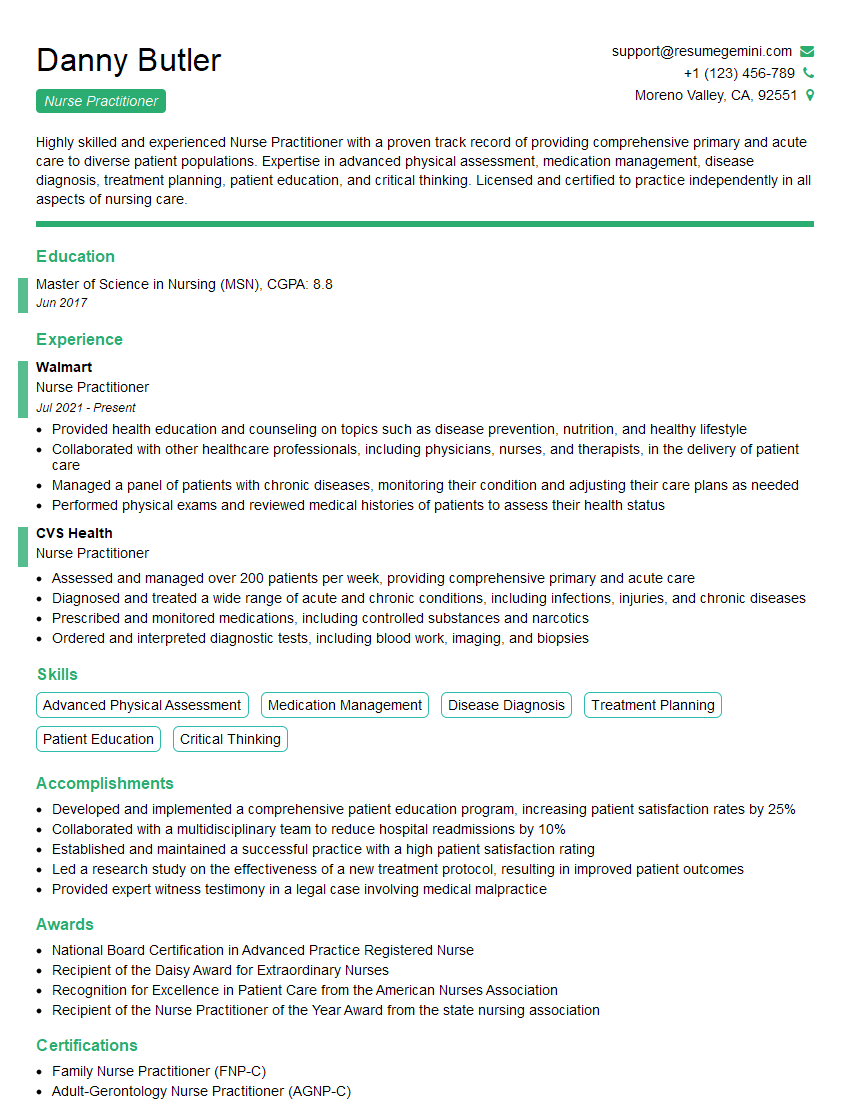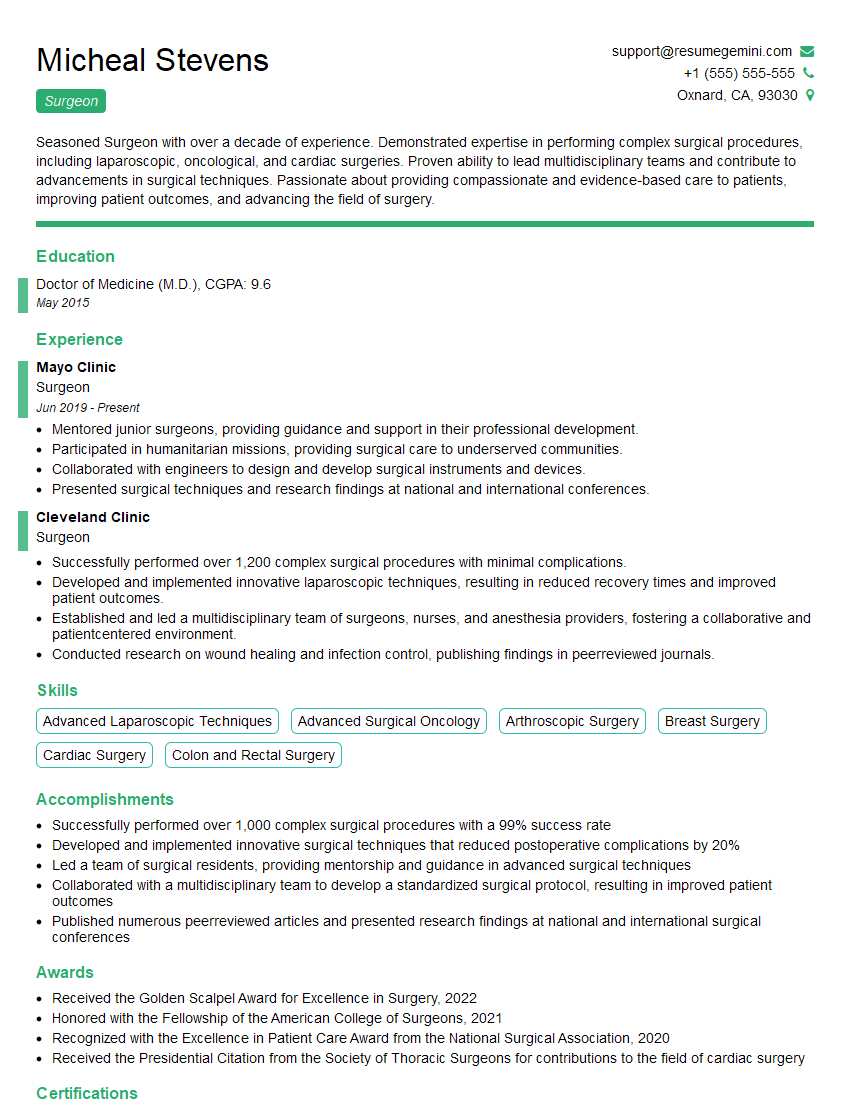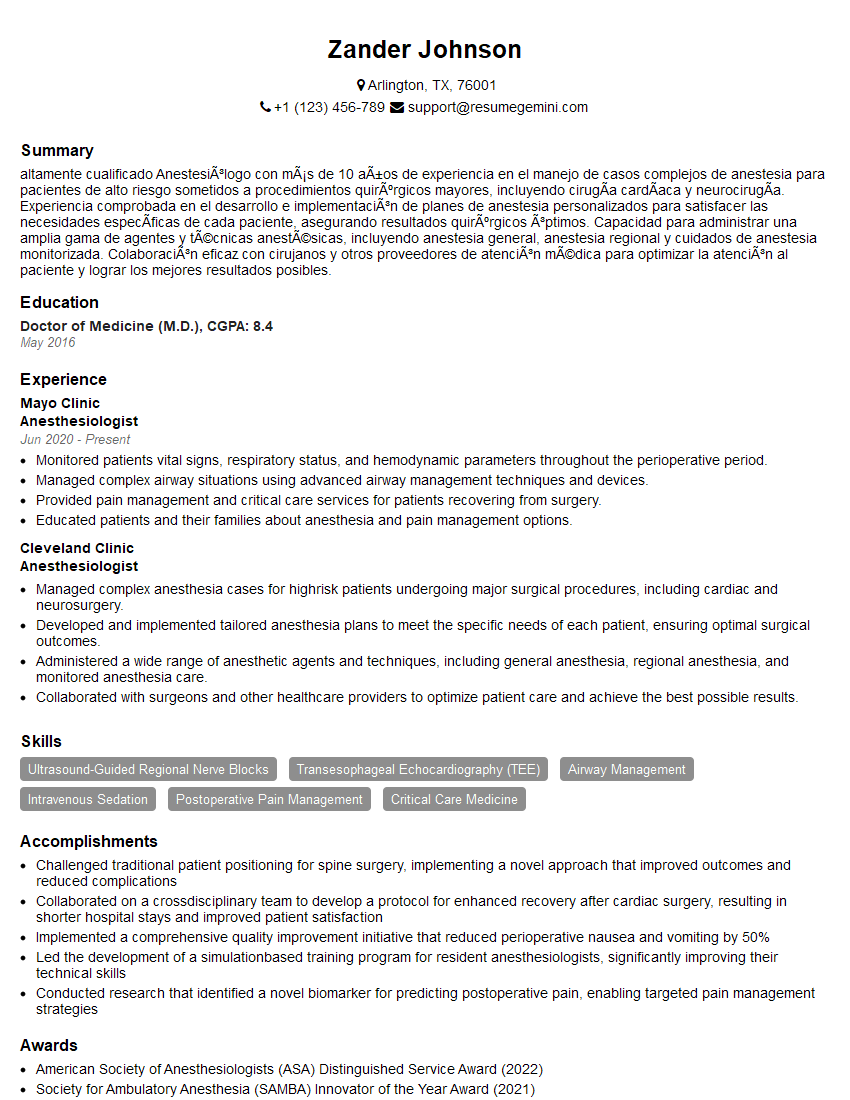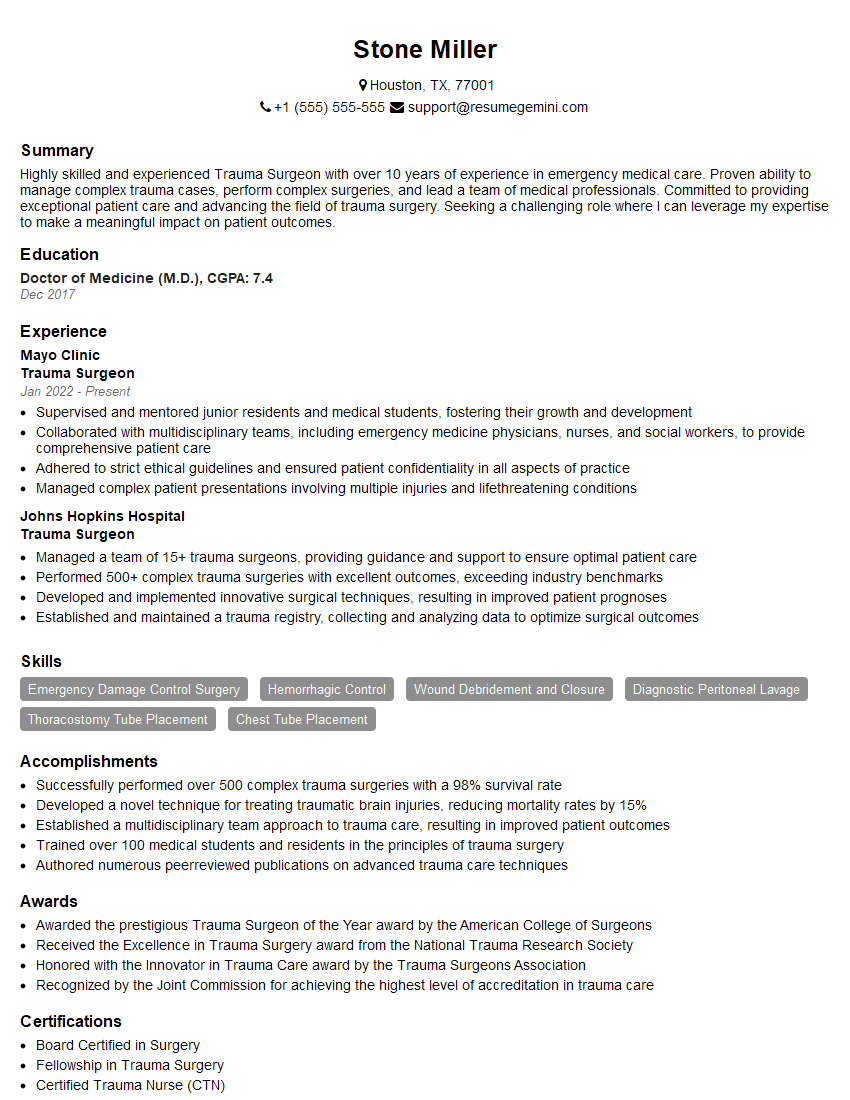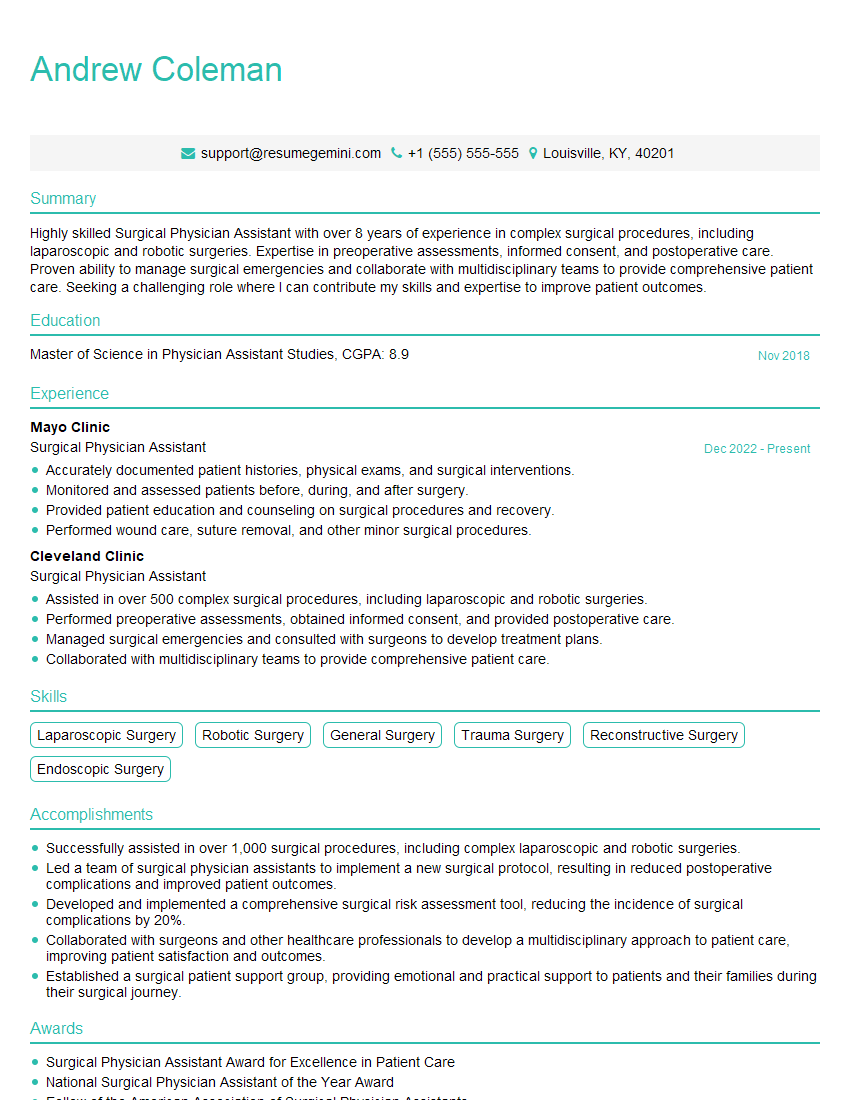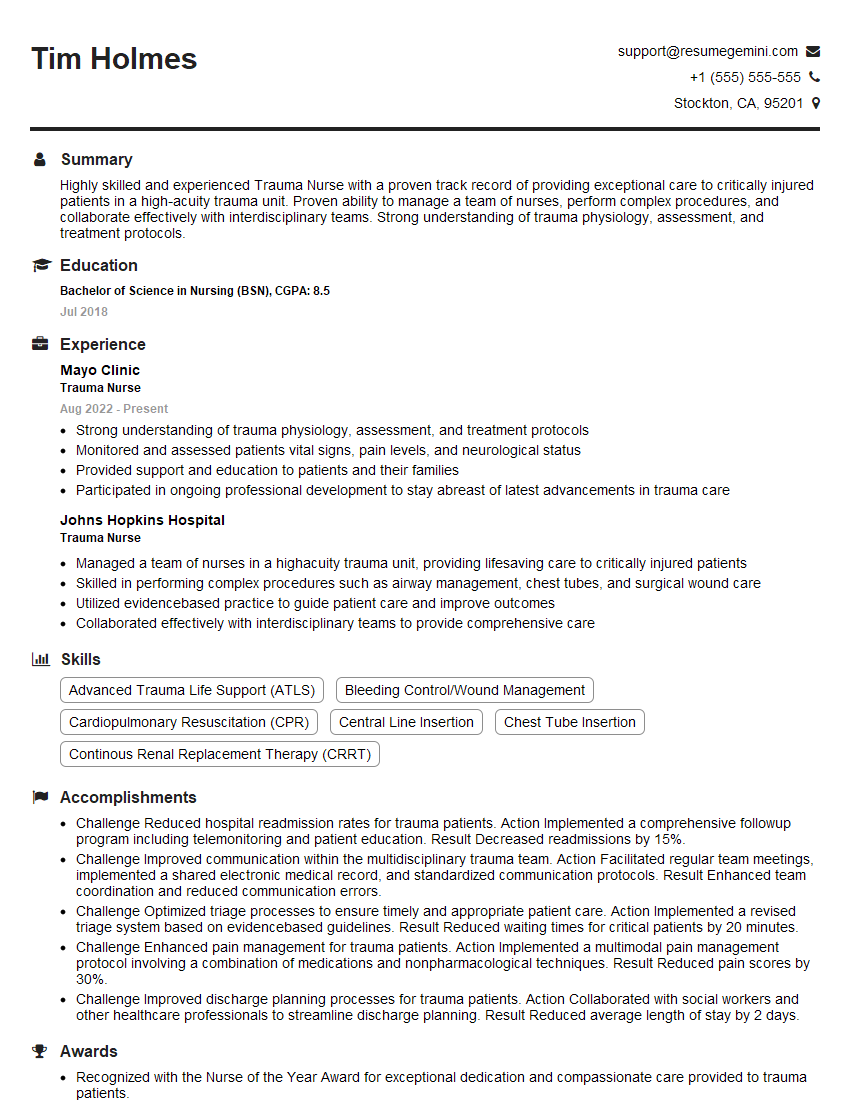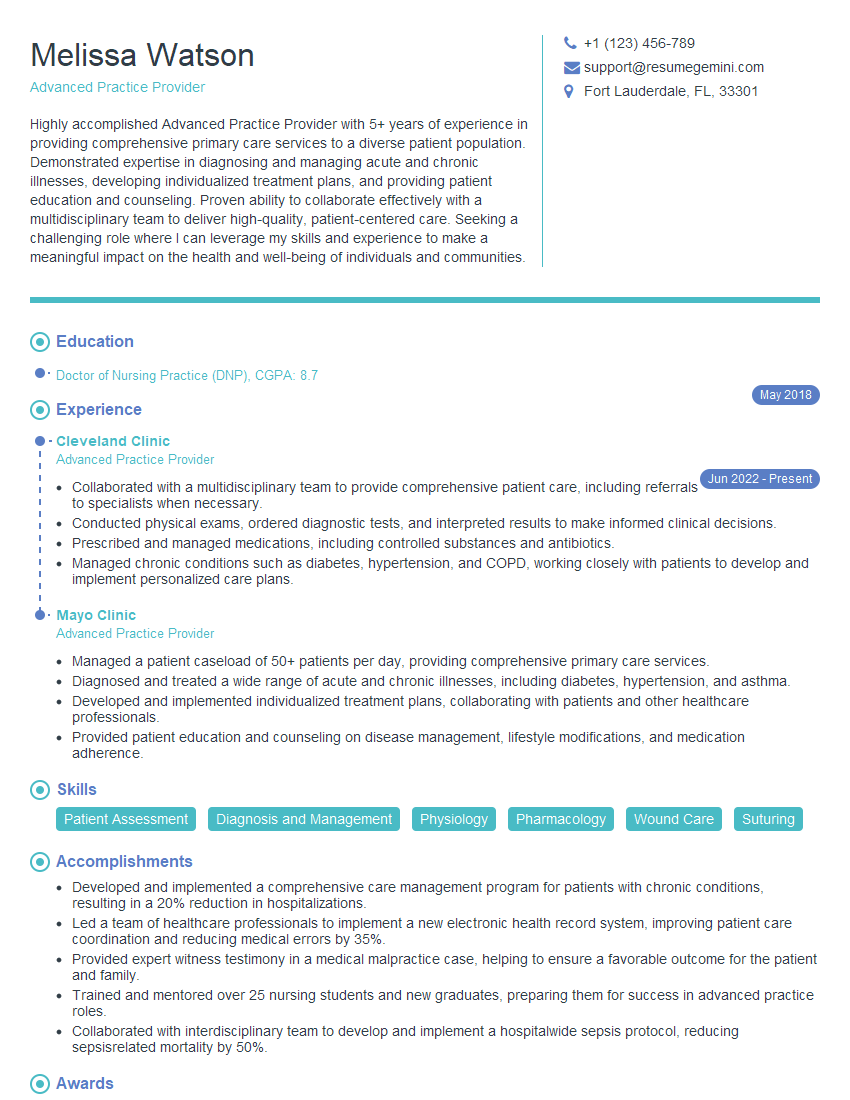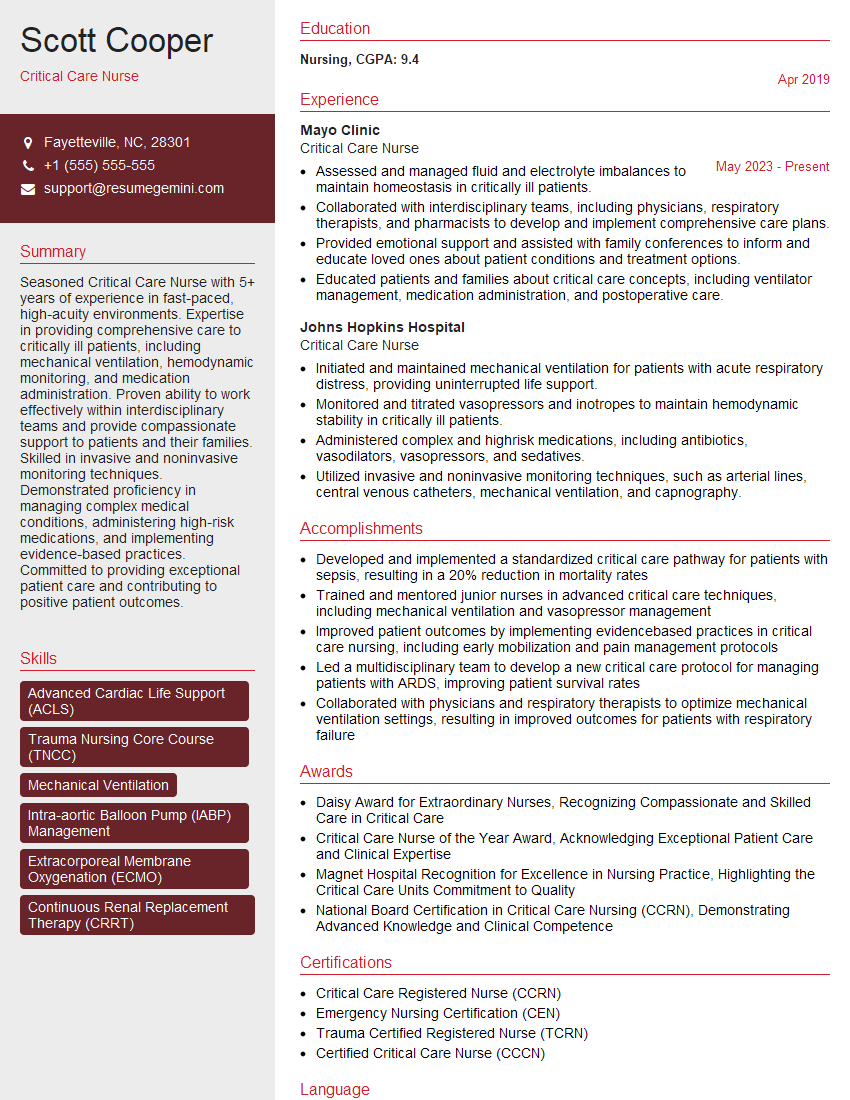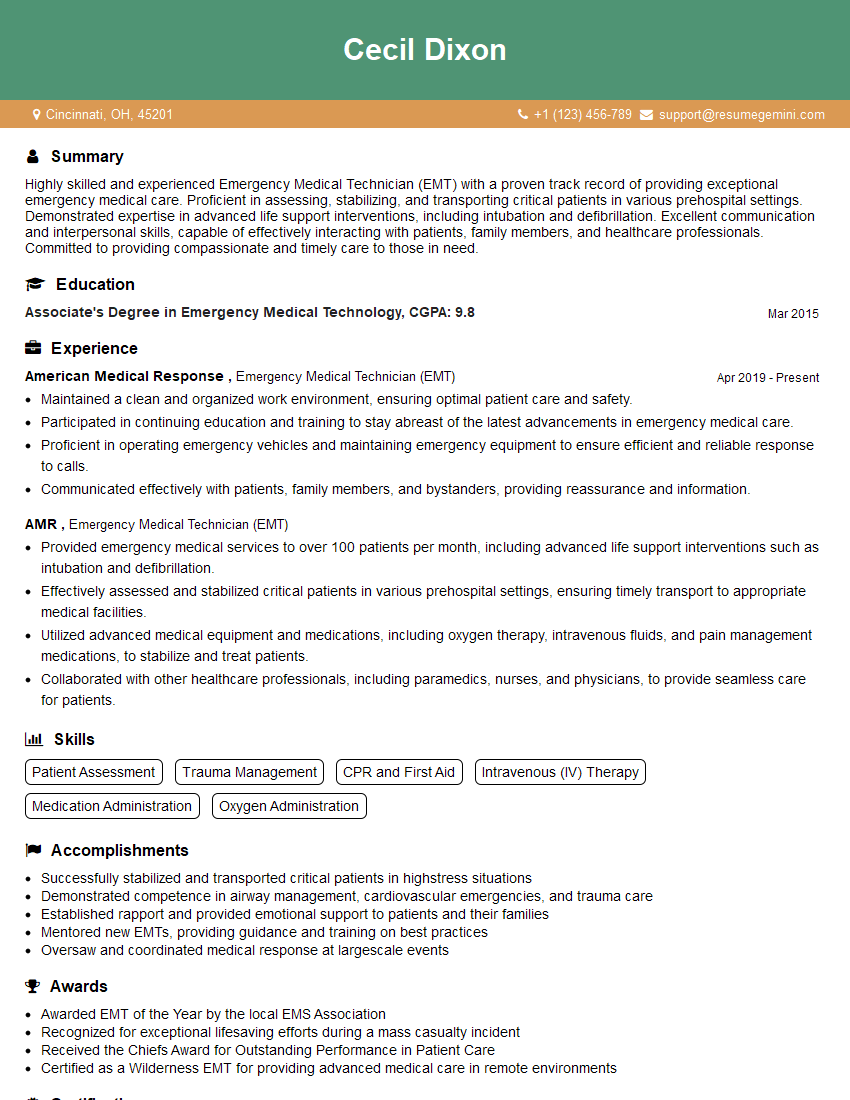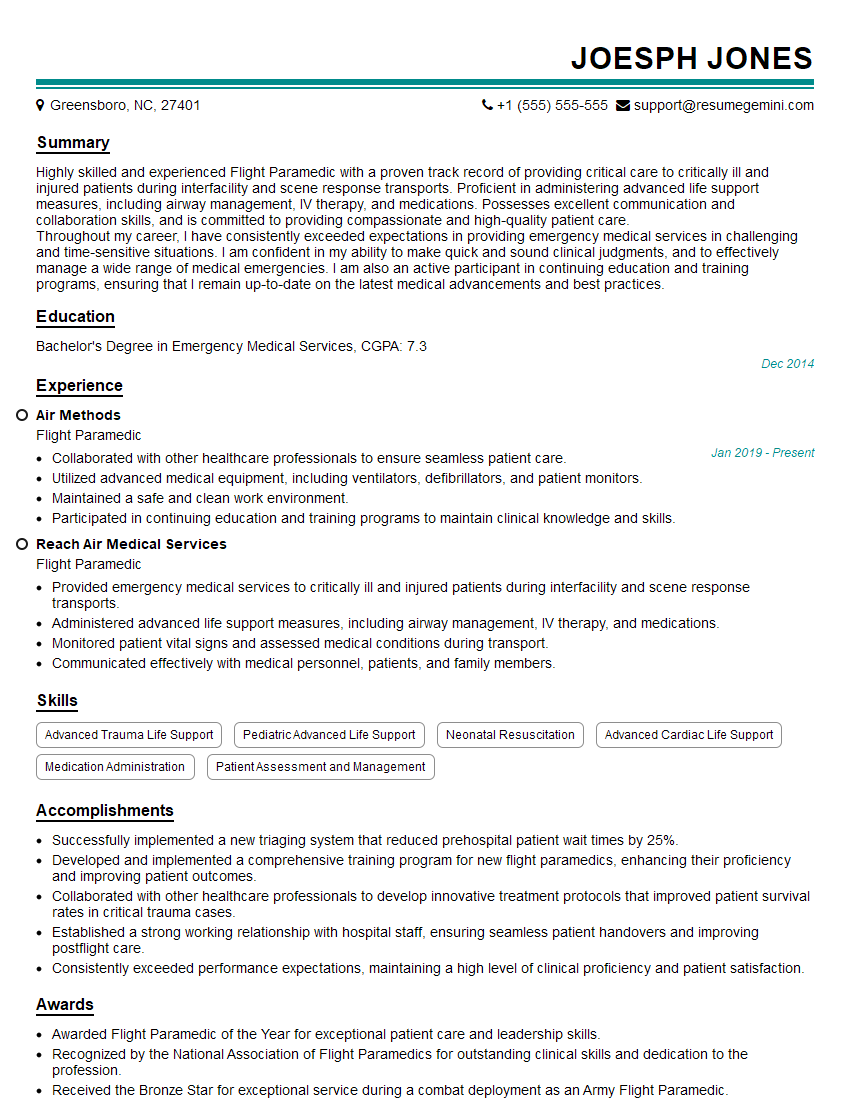The thought of an interview can be nerve-wracking, but the right preparation can make all the difference. Explore this comprehensive guide to Cricothyrotomy interview questions and gain the confidence you need to showcase your abilities and secure the role.
Questions Asked in Cricothyrotomy Interview
Q 1. Describe the anatomical landmarks for performing a cricothyrotomy.
Performing a cricothyrotomy requires precise anatomical knowledge. The cricothyroid membrane, our target, is located at the anterior neck, between the cricoid cartilage (the lower, ring-shaped cartilage) and the thyroid cartilage (the larger, Adam’s apple cartilage). Palpating these cartilages is crucial. The cricothyroid membrane is a relatively avascular area, making it a safer surgical site compared to the surrounding tissues. It’s a small area, roughly 1-2 cm wide, and lies just below the Adam’s apple. Imagine it as a small, slightly depressed area between two prominent bumps. You can easily locate it by placing two fingers on either side of the Adam’s apple and sliding your fingers down a little – you’ll feel the slight depression.
Think of it like finding the dip between two hills; once you find the dip, you’ve found your surgical landmark. Visualizing this anatomically is critical before attempting the procedure.
Q 2. What are the indications for performing a cricothyrotomy?
Cricothyrotomy is a life-saving procedure reserved for emergency situations where a patient is unable to breathe and conventional airway management techniques (like endotracheal intubation) are impossible or have failed. This includes:
- Severe upper airway obstruction: This could be due to trauma, such as a fractured larynx or severe facial injuries, or from swelling caused by burns or allergic reactions (anaphylaxis).
- Failure of endotracheal intubation: Sometimes, despite attempts, the airway cannot be secured through standard methods.
- Massive facial trauma: Injuries that make oral or nasal intubation too dangerous or impossible.
- Apnea (cessation of breathing) in an unresponsive patient where other airway techniques are failing.
Essentially, it’s a last resort to provide oxygenation when all other options are exhausted. It’s a time-sensitive procedure where speed is key to patient survival.
Q 3. What are the contraindications for performing a cricothyrotomy?
While a life-saving procedure, cricothyrotomy isn’t without limitations. Contraindications include:
- Presence of a palpable or suspected cervical injury that could make the procedure risky, such as a penetrating wound directly over the cricothyroid membrane or extensive neck trauma.
- Any condition that precludes appropriate visualization and access to the area, like significant soft tissue swelling in the neck that obscures landmarks.
- Presence of a known or suspected underlying laryngeal pathology: Pre-existing conditions in the larynx itself make the procedure more challenging and potentially dangerous.
- Anatomical variations in the neck: While rare, anatomical anomalies may make the procedure more difficult.
Remember, this procedure should only be considered when the benefits far outweigh the risks. A thorough clinical assessment is essential before deciding on this procedure. If other options exist, they should be explored first.
Q 4. Outline the steps involved in performing a cricothyrotomy.
The steps involved in a surgical cricothyrotomy can be summarized as follows:
- Preparation: Ensure sterile field, appropriate equipment, and adequate assistance.
- Identify landmarks: Locate the cricothyroid membrane as described earlier.
- Incision: Make a vertical incision (approximately 2 cm) through the skin and subcutaneous tissues directly over the cricothyroid membrane.
- Membrane incision: Make a small horizontal incision through the cricothyroid membrane itself. You should feel a slight give as the knife passes through the membrane.
- Airway insertion: Insert an endotracheal tube or a large-bore cannula into the trachea.
- Secure the airway: Inflate the cuff (if using an endotracheal tube) and confirm proper tube placement by auscultation (listening for air sounds) and observation of chest rise and fall.
- Secure the tube: Tape the tube in place, ensuring it’s secure but not constricting.
- Wound care: Cover the incision with a sterile dressing.
Each step is critical and requires precision and experience. This procedure is best performed by trained medical professionals in emergency settings.
Q 5. What equipment is required for a cricothyrotomy?
The equipment needed for a cricothyrotomy includes:
- Sterile surgical gloves and drapes
- Sterile scalpel blade (no. 11 or 15)
- Sterile forceps
- Sterile scissors
- Endotracheal tube or large-bore cannula (sizes 6-8 Fr)
- Syringe to inflate the cuff (if using an endotracheal tube)
- Tape or ties to secure the tube
- Sterile dressing
- Suction device
- Ambu bag (manual resuscitator)
Having these items readily available and organized is paramount in an emergency. Pre-prepared cricothyrotomy kits can be very helpful in managing the timing constraints of this life-saving procedure.
Q 6. Describe the different techniques for cricothyrotomy (e.g., surgical, percutaneous).
There are two main techniques for cricothyrotomy: surgical and percutaneous.
Surgical cricothyrotomy involves a surgical incision through the skin and cricothyroid membrane, as described in the previous answer. It’s more invasive but offers more control and allows for the use of a standard endotracheal tube for ventilation. This is the more traditional method often taught in emergency medical training.
Percutaneous cricothyrotomy uses a needle and catheter or a special dilating device to puncture the cricothyroid membrane. This technique is less invasive and quicker to perform, making it potentially suitable for certain emergency scenarios where speed is paramount. It’s often considered a less reliable airway compared to surgical cricothyrotomy, and the potential for complications, especially bleeding, exists.
The choice of technique often depends on the urgency of the situation, the available resources, and the provider’s experience and training. Both techniques require training and a calm, systematic approach.
Q 7. What are the potential complications of a cricothyrotomy?
Cricothyrotomy, despite being a life-saving procedure, carries significant potential complications:
- Bleeding: While the cricothyroid membrane is relatively avascular, bleeding can still occur from surrounding tissues.
- Subcutaneous emphysema: Air leaking into the surrounding tissues can cause swelling and discomfort.
- Infection: Infection of the wound is a risk, particularly if sterile technique isn’t meticulously followed.
- Tracheal perforation: Accidental puncture of the trachea can result in serious complications.
- Esophageal perforation: The esophagus lies very close to the trachea, and accidental perforation during the procedure can have lethal consequences.
- Laryngeal stenosis: Scarring following the procedure can narrow the airway over time.
- Damage to recurrent laryngeal nerve: This nerve is responsible for voice control, and its damage can lead to vocal cord paralysis.
Minimizing these complications requires proper training, meticulous technique, and a thorough understanding of the anatomy. Post-procedure monitoring is critical for early detection and management of complications.
Q 8. How do you manage bleeding during a cricothyrotomy?
Bleeding during a cricothyrotomy is a significant concern, as it can obscure the surgical field and compromise airway establishment. Effective management hinges on meticulous technique and preparedness. Before even beginning the procedure, ensure you have adequate suction readily available. This is critical for clearing the blood from the field, allowing for clear visualization of the cricothyroid membrane.
During the procedure itself, gentle manipulation of tissues minimizes trauma and bleeding. Applying direct pressure with a gauze pad to the wound after incision can also help stem minor bleeding. If significant bleeding is encountered, consider temporarily pausing the procedure to achieve hemostasis. This may involve using a surgical clamp to directly grasp and control bleeding vessels. In some cases, judicious use of local anesthetic with epinephrine can help constrict blood vessels and reduce bleeding. For severe bleeding that can’t be controlled by these measures, it might be necessary to reconsider the approach or seek assistance from a more experienced provider.
Remember, the priority is securing the airway. While controlling bleeding is important, it shouldn’t delay securing a patent airway if the patient is in immediate respiratory distress.
Q 9. How do you confirm proper placement of the cricothyrotomy tube?
Confirmation of proper cricothyrotomy tube placement is paramount to ensure successful ventilation and prevent complications. Several methods are used in conjunction. The first and most immediate is observation of bilateral chest rise and fall – a visual indication of air entry into the lungs. This is the gold standard of confirmation.
Secondly, auscultation of breath sounds over both lung fields using a stethoscope confirms the presence of air movement. Absence of breath sounds in one lung suggests tube malpositioning. Simultaneously, you should listen for air escaping from the tube, confirming the patency of the airway.
Finally, capnography (measuring end-tidal CO2) provides definitive confirmation of proper tube placement within the airway, indicating that the tube is not only in the trachea but also ventilating the lungs. The presence of a waveform with a normal ETCO2 reading is reassuring. If any of these methods are inconclusive, reassessment and possibly repositioning or even abandonment of the procedure in favor of alternative methods might be necessary.
Q 10. What are the signs of a failed cricothyrotomy?
A failed cricothyrotomy is a life-threatening situation that requires immediate recognition and intervention. Signs can be subtle or dramatic. The most obvious sign is the absence of chest rise and fall, despite positive-pressure ventilation through the tube. This suggests the air is not reaching the lungs. Auscultation of absent or unilateral breath sounds reinforces this finding.
Other signs include the inability to achieve adequate ventilation even with high airway pressures. Persistent cyanosis, despite ventilation attempts, indicates a critical lack of oxygen. Resistance to ventilation may indicate malpositioning, obstruction, or other technical issues. Subcutaneous emphysema – air leaking into the tissues of the neck – is a concerning sign indicating air is escaping from the airway into the surrounding tissues instead of the lungs. Severe bleeding that cannot be controlled might also indicate that the procedure has failed or is compromising the patient.
Q 11. How do you manage a failed cricothyrotomy?
Management of a failed cricothyrotomy demands immediate action. The first step is reassessing the airway using the above mentioned techniques and determining the cause of the failure. This might involve repositioning the tube, checking for kinks or obstructions. If repositioning fails, the next step is to consider alternative airway management techniques.
This might include attempting a surgical cricothyrotomy with a larger incision to gain better access. If this fails, the provider should immediately move to a surgical airway, such as a tracheostomy, if possible and time allows. If surgical options are unavailable or time is severely limited, consider advanced techniques like needle cricothyrotomy as a bridge to definitive airway management. Simultaneously, basic life support (BLS) and advanced cardiovascular life support (ACLS) should be initiated or continued depending on the patient’s condition to support the patient until definitive airway management is secured.
Q 12. What are the post-procedure considerations for a cricothyrotomy?
Post-cricothyrotomy care is crucial for preventing complications and ensuring patient recovery. The patient requires close monitoring of vital signs, respiratory status, and oxygen saturation. Intubation with a cuffed endotracheal tube is often maintained until a definitive airway is secured. Regular assessment for subcutaneous emphysema, bleeding, and signs of infection is necessary. The patient is often transferred to an intensive care unit (ICU) for closer monitoring and treatment for any developing complications.
Pain management is important, and the patient will likely require analgesics. The patient will need regular suctioning as needed. Depending on the reason for the cricothyrotomy, other post-operative procedures or treatments, such as addressing the underlying cause of airway obstruction, may be necessary. Prophylactic antibiotics may be given depending on local protocols and the clinical situation. Finally, patient and family education is important regarding the procedure, recovery, and potential complications.
Q 13. Describe the differences between a cricothyrotomy and a tracheostomy.
Cricothyrotomy and tracheostomy are both surgical procedures to create an airway, but they differ significantly in location, urgency, and longevity. Cricothyrotomy is a life-saving emergency procedure performed through an incision in the cricothyroid membrane, a relatively superficial structure in the neck, offering rapid access to the airway in situations of immediate respiratory distress. It is usually a temporary measure.
In contrast, a tracheostomy is a more elective procedure involving a surgical incision through the trachea lower down in the neck. It’s typically planned for long-term ventilatory support when an endotracheal tube is no longer a suitable option. Cricothyrotomy is quicker to perform, but tracheostomy offers a more stable, less traumatic, and generally more comfortable airway for prolonged use.
Think of cricothyrotomy as a quick fix for a critical situation, whereas a tracheostomy is a more permanent, carefully planned solution. Both carry risks, but the risks and potential benefits need to be considered based on the patient’s condition and time constraints.
Q 14. Discuss the role of cricothyrotomy in trauma resuscitation.
Cricothyrotomy plays a vital role in trauma resuscitation, particularly when airway compromise is present. It’s a crucial skill in managing life-threatening airway obstruction in the context of major trauma, such as maxillofacial injuries, severe facial trauma, or significant upper airway obstruction due to swelling or foreign bodies. It acts as a rapid airway rescue procedure when other methods, such as bag-valve mask ventilation or endotracheal intubation, are unsuccessful or impossible due to the nature of the injury.
In trauma settings, securing a patent airway is the top priority, often before hemorrhage control. Cricothyrotomy is performed in the field, in the emergency department, or the operating room as appropriate. Its rapid execution can be the difference between life and death for a patient with a compromised airway due to trauma. However, its use must be carefully considered and weighed against the risks inherent in this procedure, especially when other interventions are feasible.
Q 15. How do you assess the airway before attempting a cricothyrotomy?
Before attempting a cricothyrotomy, a thorough airway assessment is crucial. This involves a rapid but systematic approach focusing on identifying the degree of airway compromise and selecting the most appropriate intervention. First, we assess the patient’s level of consciousness and respiratory effort. Look for signs of respiratory distress, such as stridor (a high-pitched, wheezing sound during breathing), cyanosis (bluish discoloration of the skin), use of accessory muscles, and altered mental status. Then we check for any obvious airway obstruction, such as blood, vomitus, or a foreign body. We also assess the patient’s neck, looking for any anatomical abnormalities that might complicate the procedure, like previous surgery or trauma. A quick attempt at jaw thrust or chin lift maneuvers may also be beneficial to assess the responsiveness of the airway. If there is significant obstruction and these maneuvers fail, preparation for a cricothyrotomy should proceed immediately.
Career Expert Tips:
- Ace those interviews! Prepare effectively by reviewing the Top 50 Most Common Interview Questions on ResumeGemini.
- Navigate your job search with confidence! Explore a wide range of Career Tips on ResumeGemini. Learn about common challenges and recommendations to overcome them.
- Craft the perfect resume! Master the Art of Resume Writing with ResumeGemini’s guide. Showcase your unique qualifications and achievements effectively.
- Don’t miss out on holiday savings! Build your dream resume with ResumeGemini’s ATS optimized templates.
Q 16. What are the legal and ethical considerations surrounding cricothyrotomy?
Cricothyrotomy carries significant legal and ethical considerations. Legally, the procedure should only be performed in life-threatening situations where other airway management techniques have failed or are impossible. Consent, ideally informed consent, is paramount. In emergency situations, implied consent may be invoked. However, thorough documentation of the clinical indication for the procedure, attempts at alternative airway management, and the steps taken during the cricothyrotomy are essential to mitigate potential legal risks. Ethically, the procedure should always be the last resort, and only undertaken when the benefits significantly outweigh the risks. The physician’s duty is to act in the best interests of the patient, even if the procedure carries inherent risks. Open communication with the patient (or family if possible) regarding the urgency of the situation and the rationale behind the decision is ethically imperative, even in emergency situations. Debriefing and follow-up are important aspects of ethical practice after the procedure.
Q 17. Explain the use of bougie in cricothyrotomy.
A bougie is a flexible, introducer catheter used to facilitate the passage of the endotracheal tube (ETT) during cricothyrotomy, particularly in cases where direct visualization is difficult. It acts as a guide, helping to prevent accidental esophageal intubation. Once the cricothyroid membrane is identified and incised, the bougie is gently inserted into the trachea, confirming proper tracheal entry. The bougie’s flexibility allows it to navigate the tracheal anatomy, and its presence provides a firm channel for the subsequent ETT insertion, which then slides over the bougie. The bougie is then removed, leaving the ETT in place. Using a bougie significantly improves the safety and success rate of cricothyrotomy, particularly in emergent situations when time is of the essence and the airway anatomy may be obscured by swelling or trauma.
Q 18. What are the advantages and disadvantages of different cricothyrotomy approaches?
There are several approaches to cricothyrotomy, each with its own advantages and disadvantages. The two main approaches are the surgical cricothyrotomy and the needle cricothyrotomy. Surgical cricothyrotomy involves a larger incision and allows for the placement of a larger diameter endotracheal tube, providing better ventilation and airway management. However, it is more invasive and technically challenging, requiring more time to complete. Needle cricothyrotomy is a less invasive approach where a needle is used to create a temporary airway, ideal for immediate life-saving intervention. It’s quicker to perform and requires less expertise but provides only temporary ventilation, and the small needle cannula can lead to complications such as obstruction. The choice of approach depends on the situation and the operator’s skill and resources. Factors to consider include the urgency of the situation, the patient’s condition, and the available equipment. In a situation where immediate ventilation is critical, a needle cricothyrotomy might be preferred, followed by a surgical cricothyrotomy if more definitive airway management is necessary.
Q 19. How do you manage subcutaneous emphysema after a cricothyrotomy?
Subcutaneous emphysema, the presence of air in the subcutaneous tissue, is a common complication following cricothyrotomy. It occurs due to air leaking from the trachea during the procedure. Mild cases often resolve spontaneously. However, significant subcutaneous emphysema can restrict breathing and compromise circulation. Management focuses on supportive measures including close monitoring of respiratory status and oxygen saturation. Ensuring adequate ventilation via the established airway is critical. In severe cases, a chest tube may be considered to relieve pressure, however, this is uncommon. Supportive care and close observation are generally sufficient, and the condition typically resolves over time with careful observation and appropriate management of the primary airway issue.
Q 20. How do you address airway obstruction during a cricothyrotomy?
Airway obstruction during a cricothyrotomy is a critical event. Immediate actions are crucial. First, assess the cause of the obstruction. It might be due to bleeding, mucous plug, or kinking of the endotracheal tube. If bleeding is the cause, attempt gentle suctioning and consider applying pressure to the site. If there’s a mucous plug, try to dislodge it gently using a suction catheter. Kinking of the tube might require adjustment or replacement. If the obstruction cannot be promptly resolved, consider immediately removing the ETT and attempting to re-establish the airway using alternate methods such as a larger diameter ETT or surgical re-assessment. In some cases, it may necessitate performing a tracheostomy. The focus remains on restoring a patent airway to ensure adequate oxygenation.
Q 21. How would you explain the procedure to the patient or family (if possible)?
Explaining the procedure to the patient or family, when possible, is critical. The language should be clear, simple, and adjusted to the patient’s understanding. I would describe the situation as an emergency requiring immediate intervention to secure their airway, ensuring they can breathe adequately. I would explain the procedure as a surgical technique to create a temporary breathing opening in the neck. The language used needs to be non-technical, and the explanation should focus on the benefits and reasons for the procedure, and the risks will be minimized with immediate action. I’d emphasize that this is a life-saving procedure and, if possible, answer their questions truthfully and calmly. Reassurance and emotional support are vital during this stressful time, focusing on the urgency of the situation.
Q 22. Describe your experience with cricothyrotomies.
My experience with cricothyrotomies spans over 15 years, encompassing a wide range of scenarios from emergency situations in the operating room to pre-hospital trauma care. I’ve performed the procedure both as the primary provider and as part of a surgical team, and have extensive experience managing complications.
I’ve consistently prioritized meticulous technique, proper anatomical landmark identification, and the use of appropriate instrumentation to ensure patient safety and successful airway establishment. My training includes both didactic learning and extensive hands-on experience in high-pressure environments.
Q 23. How many cricothyrotomies have you performed?
While I cannot disclose exact patient numbers due to privacy concerns, I can say I have performed a significant number of cricothyrotomies—well into the hundreds—across various settings. This extensive experience has allowed me to develop a highly refined technique and a keen understanding of the procedure’s nuances, including its limitations and potential complications.
Q 24. Describe a challenging cricothyrotomy case you’ve encountered.
One particularly challenging case involved a severely injured trauma patient with significant facial and neck trauma, obscuring the usual anatomical landmarks for a cricothyrotomy. The patient was in profound respiratory distress. The difficulty stemmed from the distortion of the anatomy due to swelling and hematoma formation. The usual palpation techniques for identifying the cricothyroid membrane were unreliable.
To overcome this, I utilized a combination of ultrasound guidance and careful dissection using a progressively smaller scalpel blade, ensuring I could visualize the underlying structures. We successfully established an airway, ultimately saving the patient’s life. This experience underscored the critical need for advanced imaging and a nuanced approach when anatomical landmarks are compromised.
Q 25. What are some alternative airway management techniques?
Cricothyrotomy is a last resort airway technique. Alternative airway management methods should always be attempted first if possible. These include:
- Endotracheal intubation: The gold standard for airway management.
- Laryngeal mask airway (LMA): A supraglottic airway device suitable for spontaneous breathing.
- Combitube: A double-lumen airway device that can be blindly inserted.
- Retrograde intubation: A technique involving passing a catheter through the cricothyroid membrane and then using it to guide the endotracheal tube into the trachea.
- Surgical airway (tracheostomy): A more permanent airway solution that is usually performed in the operating room.
The choice of technique depends on the specific clinical situation, the patient’s condition, and the provider’s skill set.
Q 26. How do you ensure proper documentation after a cricothyrotomy?
Proper documentation after a cricothyrotomy is paramount for legal and medical reasons. My documentation includes:
- Pre-procedure assessment: Patient’s respiratory status, attempts at alternative airway management, and reasons for choosing a cricothyrotomy.
- Procedure details: Step-by-step account of the procedure, including any challenges encountered, the size and type of instruments used, and the amount of bleeding.
- Post-procedure assessment: Patient’s respiratory status, vital signs, and any complications.
- Imaging: If available, any relevant x-rays to confirm tube placement.
- Follow-up care: Plan for post-procedure management, including monitoring for complications such as bleeding, infection, or vocal cord damage.
All documentation adheres to strict institutional guidelines and legal requirements to ensure clarity, completeness, and accuracy.
Q 27. What are the common mistakes to avoid during a cricothyrotomy?
Common mistakes to avoid during a cricothyrotomy include:
- Incorrect landmark identification: Failure to accurately locate the cricothyroid membrane can lead to injury to the surrounding structures, including the esophagus, thyroid cartilage, or major blood vessels.
- Excessive force during insertion: Applying excessive force can cause trauma to the airway or surrounding tissue.
- Inadequate hemostasis: Failure to control bleeding can lead to airway obstruction.
- Improper tube placement: Incorrect placement of the tracheostomy tube may lead to inadequate ventilation or complications.
- Failure to address potential complications: Prompt recognition and management of complications such as subcutaneous emphysema, bleeding, or infection is crucial.
Careful technique, meticulous attention to detail, and a thorough understanding of the anatomy are essential to avoid these mistakes.
Q 28. How do you stay current with best practices in cricothyrotomy?
Staying current with best practices involves continuous professional development. This includes:
- Participation in continuing medical education (CME) courses and workshops: Regular attendance at conferences and workshops focusing on airway management and trauma care keeps my knowledge and skills sharp.
- Review of relevant medical literature: Staying abreast of the latest research and guidelines published in peer-reviewed journals is vital.
- Participation in simulation training: Regular participation in simulated cricothyrotomy procedures helps maintain and refine technical skills in a safe environment.
- Collaboration with colleagues: Discussing cases and challenges with colleagues provides valuable insights and learning opportunities.
By actively pursuing these methods, I can ensure my practice remains at the forefront of cricothyrotomy techniques and safety standards.
Key Topics to Learn for Cricothyrotomy Interview
- Anatomy and Physiology: Thorough understanding of the neck’s anatomy, including the location and relationship of the cricothyroid membrane, surrounding structures (e.g., thyroid cartilage, trachea), and vascular supply.
- Indications and Contraindications: Mastering the criteria for performing a cricothyrotomy, including upper airway obstruction scenarios, and understanding when it’s inappropriate or alternative techniques are preferred.
- Technique and Procedure: Detailed knowledge of the surgical steps involved, from skin incision to airway establishment, including variations in technique and potential complications.
- Equipment and Supplies: Familiarity with necessary instruments and materials, understanding their proper use and sterilization procedures.
- Complications and Management: Recognizing potential complications (e.g., bleeding, infection, esophageal perforation) and strategies for preventing and managing them. This includes post-procedure care considerations.
- Alternative Airway Management Techniques: Comparison of cricothyrotomy with other airway management techniques, including their relative advantages and disadvantages in different clinical scenarios.
- Legal and Ethical Considerations: Understanding the legal and ethical implications of performing a cricothyrotomy, particularly in emergency situations where informed consent may be limited.
- Post-Procedure Care: Knowledge of appropriate monitoring and management following the procedure, including assessing for complications and ensuring patient stabilization.
Next Steps
Mastering cricothyrotomy demonstrates advanced skills in emergency airway management, significantly enhancing your value to any healthcare team. This specialized knowledge opens doors to more advanced roles and higher responsibilities within your chosen field. To maximize your job prospects, creating a strong, ATS-friendly resume is crucial. ResumeGemini is a trusted resource to help you build a professional resume that highlights your skills and experience effectively. Examples of resumes tailored specifically to highlight Cricothyrotomy expertise are available through ResumeGemini, allowing you to present your qualifications in the best possible light. Invest time in crafting a compelling resume—it’s your first impression on potential employers.
Explore more articles
Users Rating of Our Blogs
Share Your Experience
We value your feedback! Please rate our content and share your thoughts (optional).
What Readers Say About Our Blog
Hello,
We found issues with your domain’s email setup that may be sending your messages to spam or blocking them completely. InboxShield Mini shows you how to fix it in minutes — no tech skills required.
Scan your domain now for details: https://inboxshield-mini.com/
— Adam @ InboxShield Mini
Reply STOP to unsubscribe
Hi, are you owner of interviewgemini.com? What if I told you I could help you find extra time in your schedule, reconnect with leads you didn’t even realize you missed, and bring in more “I want to work with you” conversations, without increasing your ad spend or hiring a full-time employee?
All with a flexible, budget-friendly service that could easily pay for itself. Sounds good?
Would it be nice to jump on a quick 10-minute call so I can show you exactly how we make this work?
Best,
Hapei
Marketing Director
Hey, I know you’re the owner of interviewgemini.com. I’ll be quick.
Fundraising for your business is tough and time-consuming. We make it easier by guaranteeing two private investor meetings each month, for six months. No demos, no pitch events – just direct introductions to active investors matched to your startup.
If youR17;re raising, this could help you build real momentum. Want me to send more info?
Hi, I represent an SEO company that specialises in getting you AI citations and higher rankings on Google. I’d like to offer you a 100% free SEO audit for your website. Would you be interested?
Hi, I represent an SEO company that specialises in getting you AI citations and higher rankings on Google. I’d like to offer you a 100% free SEO audit for your website. Would you be interested?
good

